The parametric equations for a curve in the plane consists of a pair of equations
![]()
Each value of the parameter t gives values for
x and y; the point ![]() is the corresponding point on
the curve.
is the corresponding point on
the curve.
For example, consider the parametric equations
![]()
Here are some points ![]() which result from plugging in
some values for t:
which result from plugging in
some values for t:
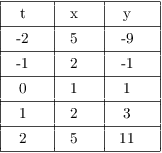
The graph of the curve looks like this:
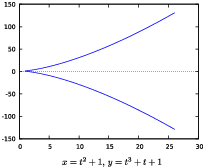
These are parametric equations for the circle ![]() :
:
![]()
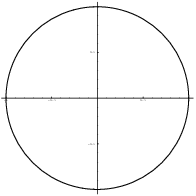
You can sometimes recover the x-y equation of a parametric curve by eliminating t from the parametric equations. In this case,
![]()
Notice that the graph of a circle is not the graph of a function. Parametric equations can represent more general curves than function graphs can, which is one of their advantages.
These parametric equations represent a spiral:
![]()
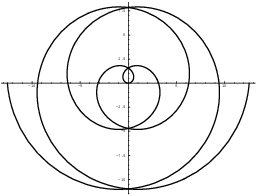
This is also not the graph of a function ![]() .
.
Example. Find the x-y equation for
![]()
Solve the x-equation for t:

Plug this expression for t into the y-equation:
![]()
Example. Find the x-y equation for
![]()
Notice that
![]()
So
![]()
This is the standard form for the equation of an ellipse.![]()
In some cases, recovering an x-y equation would be difficult or impossible. For example, these are the parametric equations for a hypocycloid of four cusps:
![]()
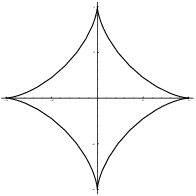
In this case, it would be difficult to eliminate t to obtain an x-y equation.
What about going the other way? If you have a curve (or an x-y equation), how do you obtain parametric equations?
Note first that a given curve can be represent by infinitely many
sets of parametric equations. For example, all of these sets of
parametric equations represent the unit circle ![]() :
:
![]()
![]()
![]()
Even so, it can be difficult to find parametrizations for curves.
Let's start with an easy case. If you have x-y equations in which x
or y is solved for, it's easy. For example, to parametrize ![]() , set
, set ![]() . Then
. Then ![]() . A parametrization is given by
. A parametrization is given by
![]()
To parametrize ![]() , set
, set ![]() . Then
. Then ![]() , so
, so
![]()
This is a parametrization of ![]() . (This is
how you can graph x-in-terms-of-y equations on your calculator.)
. (This is
how you can graph x-in-terms-of-y equations on your calculator.)
Here's another important case. If ![]() and
and ![]() are points, the line through
are points, the line through ![]() and
and ![]() may be parametrized by
may be parametrized by
![]()
It is easiest to remember this in the vector form
![]()
Notice that when ![]() , I have
, I have ![]() , and when
, and when ![]() ,
, ![]() . Thus, if you let
. Thus, if you let ![]() , you get the
segment from
, you get the
segment from ![]() to
to ![]() .
.
Example. Find parametric equations for the
line through ![]() and
and ![]() .
.

Thus,
![]()
An analogous result holds for lines in 3 dimensions (or in any number of dimensions).
As an example of a more general method of parametrizing curves, I'll
consider parametrizing by slope. The idea is
to think of a point ![]() on the curve as the
intersection point of the curve and the line
on the curve as the
intersection point of the curve and the line ![]() :
:
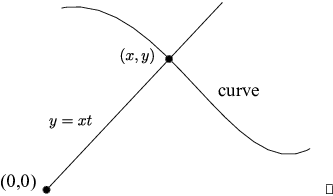
The slope t will be the parameter for the curve.
Example. Find parametric equations for the Folium of Descartes:
![]()
Set ![]() . Then
. Then
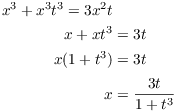
Therefore, ![]() . A
parametrization is given by
. A
parametrization is given by
![]()
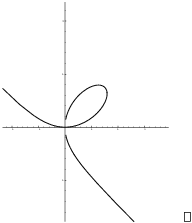
The first and second derivatives give information about the shape of a curve. Here's how to find the derivatives for a parametric curve.
First, by the Chain Rule,
![]()
Solving for ![]() gives
gives

Example. Find the equation of the tangent line to the curve
![]()
![]()
When ![]() ,
, ![]() and
and ![]() . The tangent line is
. The tangent line is
![]()
Example. At what points on the following curve is the tangent line horizontal?
![]()
Find the derivative:
![]()
The tangent line is horizontal when ![]() , and
, and ![]() for
for ![]() and for
and for ![]() .
.
When ![]() ,
, ![]() and
and ![]() . When
. When ![]() ,
, ![]() and
and ![]() . There are horizontal
tangents are
. There are horizontal
tangents are ![]() and at
and at ![]() .
.
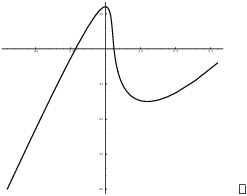
To find the second derivative, I differentiate the first derivative.
![]()
Since ![]() will come out in terms of t, I want to be
sure to differentiate
will come out in terms of t, I want to be
sure to differentiate ![]() with respect to
t. Use the Chain Rule again:
with respect to
t. Use the Chain Rule again:
![$$\der {} x \left(\der y x\right) = \der t x\cdot \left[\der {} t \left(\der y x\right)\right] = \dfrac{\der {} t \left(\der y x\right)}{\der x t}.$$](parametric-equations88.png)
That is,

Example. Find ![]() and
and ![]() at
at
![]() for
for
![]()
First,
![]()
So

When ![]() , I have
, I have ![]() .
.
Next,
![]()
So

When ![]() , I have
, I have ![]() .
.![]()
Copyright 2020 by Bruce Ikenaga